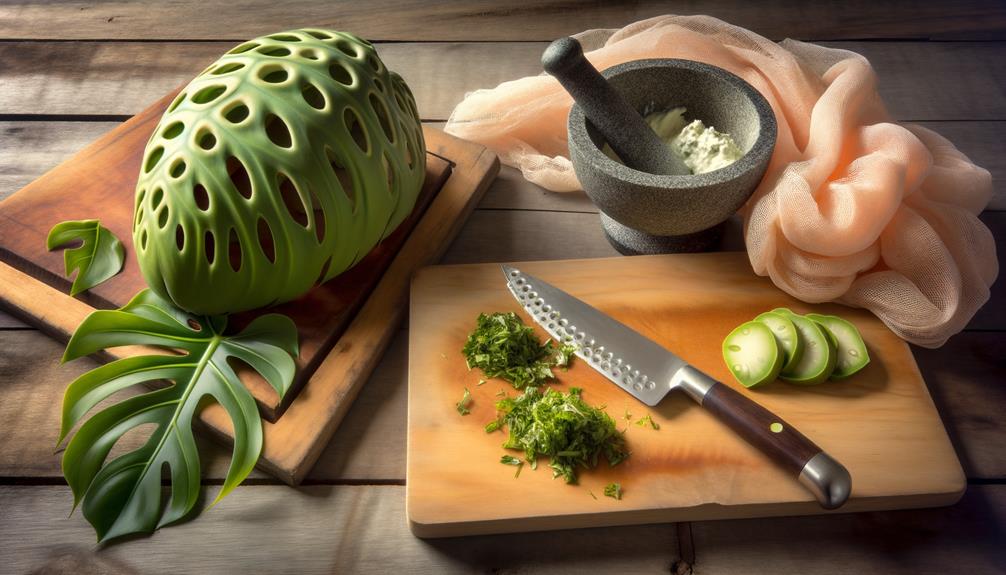How to Make Monstera Deliciosa Cheese
To create Monstera Deliciosa cheese, begin by choosing ripe Monstera fruits with green scales that separate easily and a banana-like fragrance. Extract the ripe pulp, being careful to avoid unripe sections, and blend it with high-quality cream cheese, fresh herbs, honey, and a hint of sea salt.
Heat the mixture to 86°F and add rennet, allowing it to sit until curds form. Rotate the cheese regularly during aging for consistent flavor and texture.
Store it in a cheese cave or refrigerator with proper airflow and humidity. For a more in-depth exploration into each step, stay tuned for more details.

Key Takeaways
- Select ripe Monstera fruits with green scales separating and a banana-like aroma.
- Extract Monstera pulp by peeling scales, discarding unripe sections, and scooping out seeds and fibrous bits.
- Mix 200g Monstera pulp with 100g soft cream cheese, 50g honey, and a pinch of sea salt.
- Heat the mixture to 86°F (30°C), add rennet, stir gently, and let sit for 45 minutes to form curds.
- Store cheese in a dedicated refrigerator, turning it every other day to ensure even aging and flavor distribution.
Selecting Ripe Monstera Deliciosa
To create the best Monstera Deliciosa cheese, you must first select fruit that's perfectly ripe. Look for a fruit where the green scales have started to separate, revealing a creamy texture beneath. This indicates ripeness and guarantees the fruit is safe to eat.
Smell the fruit; a sweet, banana-like aroma signals it's ready. Gently squeeze it, and if it yields slightly, it's perfect. Avoid any fruit with brown spots or an overly soft texture, as these are signs of overripeness.
Patience is essential here; unripe Monstera Deliciosa contains oxalic acid, which can be harmful. By selecting the right fruit, you'll set the foundation for a delicious and safe Monstera Deliciosa cheese.
Preparing Your Ingredients
Now that you've chosen ripe Monstera Deliciosa, it's time to focus on selecting the freshest additional ingredients.
Precision is key here—accurately measure each component to guarantee the perfect balance of flavors.
Your attention to detail will make all the difference in creating exquisite cheese.
Selecting Fresh Ingredients
Start by selecting ripe Monstera deliciosa fruits, making sure they're free from blemishes and have a fragrant aroma. These fruits should have a slight give when gently pressed, indicating ripeness. Avoid fruits that are too firm or overly soft, as these can affect the texture and flavor of your cheese.
Next, gather fresh, high-quality milk, preferably organic and full-fat, to guarantee a rich, creamy base. Choose fresh herbs like basil, thyme, or rosemary to enhance the cheese's flavor. Don't forget to use sea salt for a clean, pure taste.
Lastly, make sure all your utensils and surfaces are meticulously clean to maintain the integrity and safety of your ingredients. Your attention to detail will make all the difference.
Measuring Proper Quantities
Accurately measuring your ingredients is crucial for achieving the perfect balance of flavors and textures in your Monstera deliciosa cheese. Start by using a digital scale for precision.
Weigh out 200 grams of ripe Monstera fruit pulp, making sure it's free from seeds and skin. Next, measure 100 grams of soft cream cheese, which will blend seamlessly with the fruit.
For the sweetener, use 50 grams of honey; its natural sweetness complements the unique taste of Monstera. Finally, don't forget a pinch of sea salt to enhance all the flavors.
This careful measurement guarantees your cheese has the right consistency and taste. Precision isn't just a detail—it's the difference between good and extraordinary Monstera deliciosa cheese.
Extracting Monstera Deliciosa Pulp
To start extracting Monstera deliciosa pulp, you'll need to harvest only the ripest fruit, ensuring best flavor and texture.
Once you've collected your fruit, carefully prepare the pulp by removing the skin and seeds.
Harvesting Ripe Monstera Fruit
When the hexagonal scales on the Monstera fruit begin to separate, it's the perfect time to harvest and extract the delicious pulp hidden within. Carefully pluck the fruit from the plant, making sure you don't damage the tender flesh.
You'll notice a sweet, tropical fragrance that signals ripeness. Gently peel away the scales with your fingers, exposing the creamy, aromatic pulp. Be patient—only the segments where the scales have loosened are ready to eat.
Discard any unripe sections, as they'll cause irritation. Use a spoon to scoop out the succulent pulp, making sure you avoid the core. This meticulous process guarantees you get the best flavor and texture from your Monstera fruit, setting the stage for your delicious Monstera Deliciosa cheese creation.
Preparing the Fruit Pulp
Now that you've harvested the ripe Monstera fruit, it's time to meticulously prepare the pulp for your exquisite Monstera Deliciosa cheese.
Begin by gently peeling away the hexagonal scales from the fruit's surface. You'll notice the pulp beneath is soft and fragrant. Using a spoon, carefully scoop out the juicy segments, making certain you avoid any unripe, green portions which can be irritating.
Work methodically, collecting the pulp in a clean bowl. Take your time to remove any seeds or fibrous bits, as these can impact the final texture of your cheese. Precision here guarantees a smooth, flavorful result.
Once you've gathered all the pulp, you're ready for the next step in transforming this tropical delight into a delectable cheese.
Straining for Pure Extract
Begin by using a fine-mesh strainer or cheesecloth to separate the liquid essence from the Monstera Deliciosa pulp, ensuring a pure extract for your cheese. This step is essential for achieving the perfect texture and flavor.
Here's how to do it:
- Prepare Your Tools: Have a clean bowl, fine-mesh strainer, or cheesecloth ready.
- Strain the Pulp: Pour the blended pulp into the strainer or cheesecloth, allowing the liquid to drip into the bowl.
- Press Gently: Use a spoon or your hands to press the pulp, extracting every drop of essence.
- Collect the Extract: Transfer the strained liquid to a clean container for use in your cheese-making process.
Creating the Cheese Mixture
To make the cheese combination, mix shredded Monstera deliciosa fruit with a blend of ricotta and mascarpone in a mixing bowl. Make certain both cheeses are at room temperature for easier blending.
Use a spatula to fold the ingredients together until you achieve a smooth, uniform consistency. The Monstera's unique tropical notes will meld beautifully with the creamy texture of the cheeses, creating a base that's both rich and revitalizing.
Taste as you mix to ensure a balanced flavor profile. If necessary, adjust with a pinch of salt or a dash of lemon juice to enhance the overall taste. Remember, precision and patience are key to achieving that perfect cheese mixture.
Curds Formation Process
With your cheese mixture ready, the next step is to initiate the curds formation by heating the blend gently and adding a coagulant like rennet. You'll need to maintain a steady temperature around 86°F (30°C) to guarantee successful curdling.
Stir the mixture slowly to distribute the rennet evenly, then let it sit undisturbed for about 45 minutes.
Follow these steps:
- Heat the mixture to 86°F (30°C): Use a thermometer for accuracy.
- Add rennet: Follow the package instructions for the correct amount.
- Stir gently: Guarantee the rennet is evenly mixed.
- Let it sit: Allow 45 minutes for curds to form.
Pressing and Shaping the Cheese
Transfer the curds into a cheesecloth-lined mold, applying steady pressure to expel excess whey and shape the cheese. Guarantee the pressure is even, so the cheese develops a consistent texture. Use a pressing schedule that gradually increases intensity to achieve the perfect firmness. Here's a guide:
| Time (Hours) | Pressure (lbs) | Notes |
|---|---|---|
| 0-1 | 5 | Initial gentle press |
| 1-4 | 10 | Increase gradually |
| 4-8 | 20 | Firming up |
| 8-12 | 30 | Final press |
| 12+ | 40 | Extra firm |
Monitor the cheese closely, flipping it periodically to confirm uniformity. By the end of the pressing period, you'll have a beautifully shaped Monstera Deliciosa cheese ready for the next steps.
Aging and Storing the Cheese
Aging your Monstera Deliciosa cheese is a critical step that develops its unique flavor and texture. You'll need patience and precision to achieve best results.
Here's how to age and store your cheese effectively:
- Temperature: Maintain a consistent temperature of 50-55°F (10-13°C) in your aging space.
- Humidity: Keep humidity levels between 80-85% to prevent your cheese from drying out.
- Turning: Rotate the cheese every other day to ensure uniform aging.
- Storage: Use a cheese cave or a dedicated refrigerator with proper airflow to foster ideal conditions.
Conclusion
You've now mastered the art of crafting Monstera Deliciosa cheese. By selecting ripe fruit, skillfully extracting the pulp, and carefully forming curds, you've created a culinary marvel.
Pressing and aging the cheese guarantees a rich, complex flavor. Remember, your patience and precision transform simple ingredients into a delectable masterpiece.
So, trust the process, savor the results, and share your newfound expertise with others. Your journey into the world of Monstera Deliciosa cheese has just begun!






